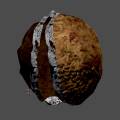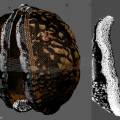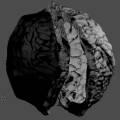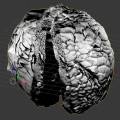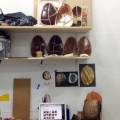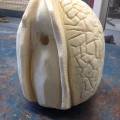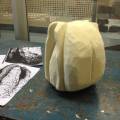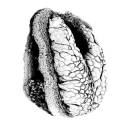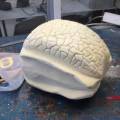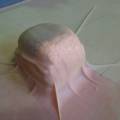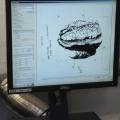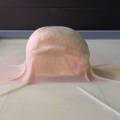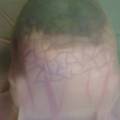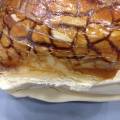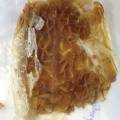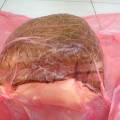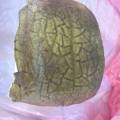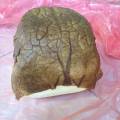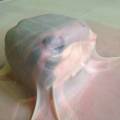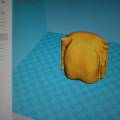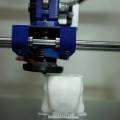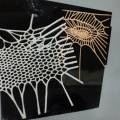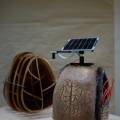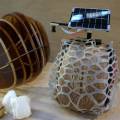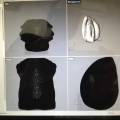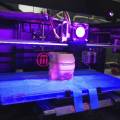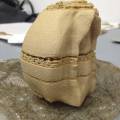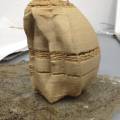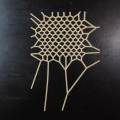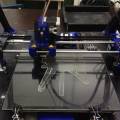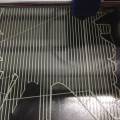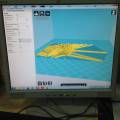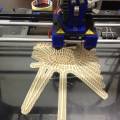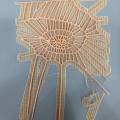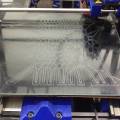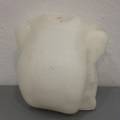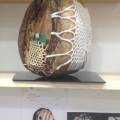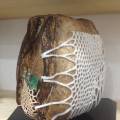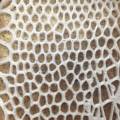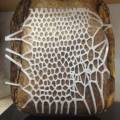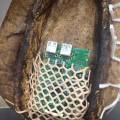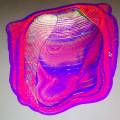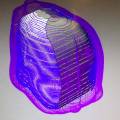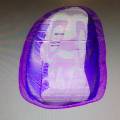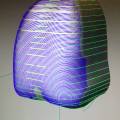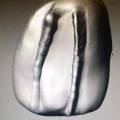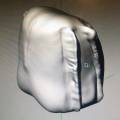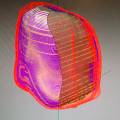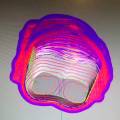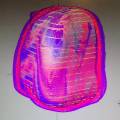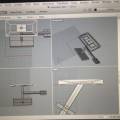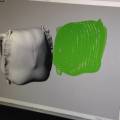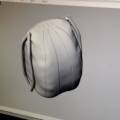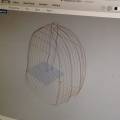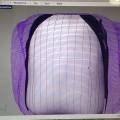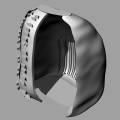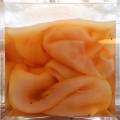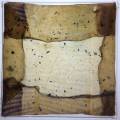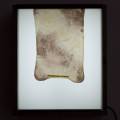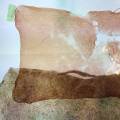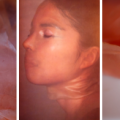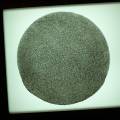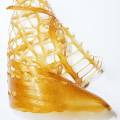Table of Contents
starting point: the story behind the concept
The project 'Guerilla Beehives'has an exemplary meaning when it comes to the public perception of sustainability. It is a collaboration between the arts, design and science.
This is the end of the anthropocene. We imagine an ecosystem where all actors collaborate to keep up the resilience of the system. As artists, beekeepers, makers and thinkers, we collaborate with animals, plants, insects and bacteria. We co-design Intelligent Guerilla Beehives: supportive shelters for bee swarms. In return, the bees provide us with information on the ecosystem that is hosting the Guerilla Beehive. Driven by the intelligence, complexity and self-organisation of the Super Organism (bee swarm) we discuss and explore in a democratic way. This is not a study of-, but a development together with 'the other organism'. This collaboration should lead to a more diverse and thus more resilient system, post human and post anthropocentrism. Animal politics are taken into account. We go for an embodied experience, non-linear, immanent and interacting with the non-human other.
An emergent collective intelligence; single agents teaming up without any decision maker. Important is the arrangement and relationship of the parts which provokes the emergence of a bottom-up intelligence in this self-managed group with independent actuators. The group is build on diversity which provides resilience. They are offered a shelter -prototyped by nature- which is designed to grant equilibrium and homeostasis (variables are regulated so that internal conditions remain stable and relatively constant).
'The Disappearance of the Honey Bees' laat eveneens toe om onderzoek te voeren naar de positie van de mens tegenover de natuur in grootstedelijke context. Natuurkunde, biologie, botanica, politiek en economie maken allemaal deel uit van dit complexe ecosysteem.
Guerilla Beehive - Project Page
Bee colonies are threatened in all industrialized nations. Given that the survival of bees is crucial for human sustainability, there is a great urgency to improve by all means the ways in which colonies could thrive.
In 2009 I founded the Brussels Urban Bee laboratory (http://urbanbeelab.okno.be), the place of action for a group of artists, scientists and technologists to observe bee colonies in non intrusive set-ups. The Urban Bee Lab is also a vehicle to raise public awareness via art installations and workshops.
The Guerilla Beehive project is one of these actions. It proposes a shelter for swarming bee colonies and supports the bees in their roles as pollinators and caretakers of biodiversity rather than as honey producers. In this project, bees, humans and plants - are working together to assure a sound basis for the further development of our ecosystem.
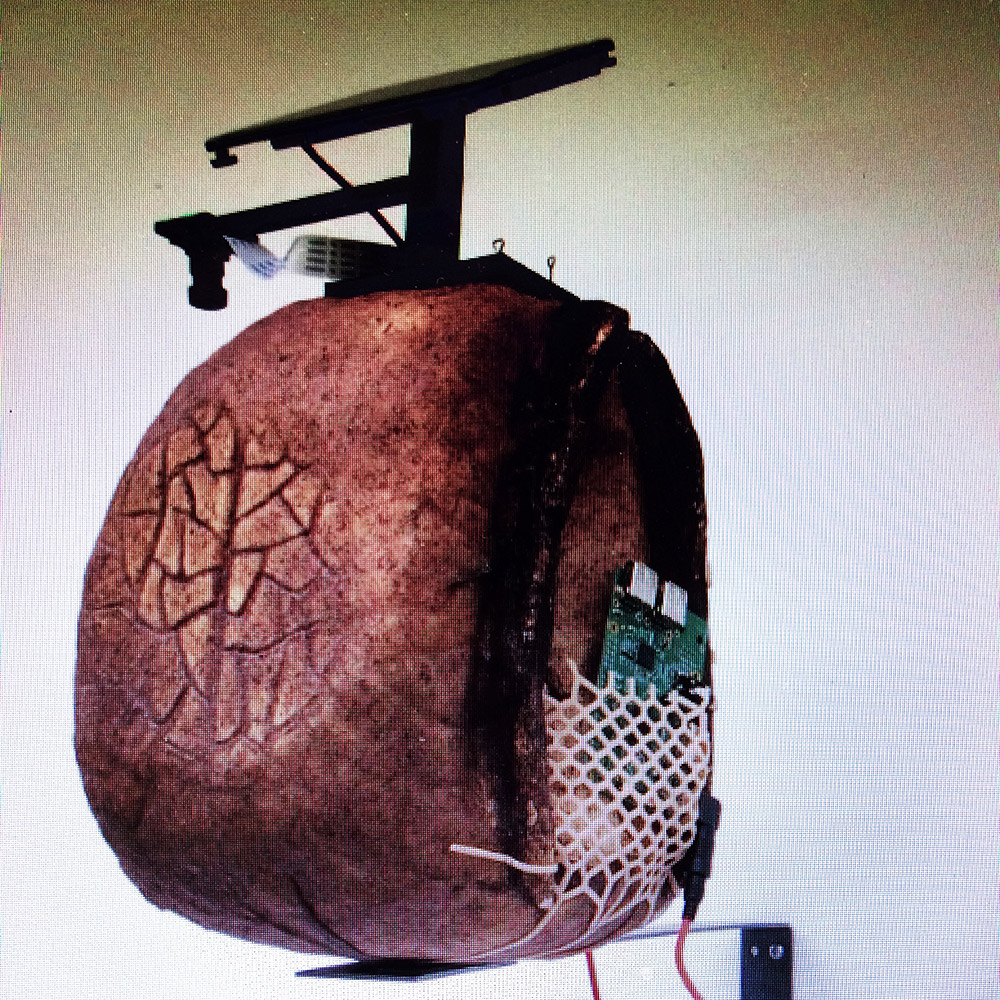

The pictures above present a scale model (35cm x 30cm x 30cm)) of the Guerilla Beehive. The form is inspired on a pollen grain of a Fragaria vesca (a wild strawberry). The model is sculpted in high density foam and is cladded with a skin in bioplastic, made on the basis of Psyllium ovata. The model+skin are vacuum pressed to reveal the embossed voronoi design on the front of the hive.
The hive-entrance is in between the wind-protective wings on the left side. The entrance is monitored by a camera and the processed images are send via bluetooth to a monitor. The camera is powered by a Raspberry Pi which is hosted at the other side of the beehive, in a small 3D-printed pocket. The back of the hive is decorated with a 3D-printed voronoi design in flexible filament. The solarpanel is fixed on a 3D-printed solarpanel holder.
The design of the Guerilla Beehive is inspired by nature. The content (± 40 liters) responds to the nest-needs of a bee colony living in the wild, and the mobile architecture makes it easily deployable on different spots in public space, hence its name: the Guerilla Beehive. The hive can be grafted on the wall of a building or wrapped around the branch of a tree in a park (the bees prefer a 'higher' spot, south-east oriented). The beehive has been enhanced with a sensor network in order to monitor the health of the colony without interference and thus allow better care. The Guerilla Beehive is made out of smart organic materials with usefull properties in respect to temperature fluctuation, humidity and ventilation. The hive has a high tactile potential; the flexible rubber of the outer skin and the warm and soft cork of the inner skin invite to touch and feel. All materials are biodegradable. Once the colony decides to leave the hive, the Guerilla Beehive will fall as a ripe apple from the tree and decompose completely. It is a cradle to cradle design.
Another project inspired on the Thomas Seely-research in 'Bee Democracy', on housing habits of bees in the wild:
bed-breakfast_voor_honingbijen.pdf
darwin_cure.pdf
biomimicry-learning_from_nature.pdf
Because bees are recognized as important biomarkers, the Guerilla Beehive is augmented with sensors and sensory processing algorithms that analyze the quality of pollen and propolis as well as the behavior of the bees in order to monitor the state of the ecology in the surrounding area.
The Guerilla Beehive can have a major impact on the sustainability of bees, agriculture and plant life. On top, the project innovates also in ICT by adopting a Green ICT approach at all levels: the structure of the hive is built using parametric design and is fabricated with 3D printing and milling facilities. The hive's ICT components will be powered by solar panels and microbial fuel cells using the bodies of dead bees and honey as source, so that the system is self-sufficient in terms of energy. The processing and telecommunication infrastructure will exploit techniques of low energy computation. In this project we are not only building prototypes of the Guerilla Beehive but we are also conducting field studies in urban and peri-urban areas, and we exploit the results using open source hard- and software methodologies.
The Brussels Urban Bee Lab is an independent international collective of artists, scientists, beekeepers, technicians and creative people. The BUBL uses artistic, scientific and technological research approaches to tackle challenges related to sustainability and the monitoring and survival of city honeybees. Bee colonies are currently threatened in Europe at an alarming rate and BUBL’s research is therefore of great importance, both by raising awareness and by providing unprecedented data for studying bee colony collapse disorder.
An extensive rooftop garden in the centre of Brussels hosts the headquarters of the BUBL laboratory. It is giving place to several experimental beehives and instrumentation equipment. From this laboratory, data is continuously being broadcast through streaming technology.
Check the other research projects of the Brussels Urban Bee Laboratory on this project-wiki. Discover the Transparent Beehive project, the Sound Beehive project, the Color Coded Beehive, the Pollen Database, the Material Science research, the eco-data visualization, … and more research projects.
design outside
The 'wrap-around' design consists of 2 parts: 1 big bag which is hosting the nest of the bee colony, and 1 smaller bag which is housing the observation technology - at the same time, the smaller bag acts as the counter weight for the bigger bag.
The hive-part has a content of 40 liters. The outer skin is printed in rubber. It has an irregular spiky form which is inspired by the surface of a seedpod and it has qualities of camouflage when fixed to a tree. The rubber spikes adapt to variable weather conditions. At the inside, the nest-volume is lined with cork. Between the outer and inner skin there is a vacuum (similar to cell-membranes) filled with air. This air-filled space adjusts the thermoregulation in the hive and helps the bees to maintain the ideal temperature of 35°C. The cork wall has micropores (inspired by the pores in radiolaria) which allow for a humidity regulation around 55%. Both outer and inner wall are designed to manage the beehive's homeostasis.
- wrap-around version
- backpack version
- grocery bag version
- rope version
materials, functionalities and technology
Resilient parametric structure, modelled after pollen of the Fragaria (strawberry).
Design of the outside skin provides following qualities: ventilation/stomata, thermoregulation/reflective_absorbative colors, insonorisation qualities, …
Sensors and actuators. Embedded mesh network of thermistors.
- compare sensors to form, material, functionality and emplacement of hairs on plants and bees
- compare additive solarpanels to emplacement and functionality of plant leaves
- microbial fuel cells integration.
inside: spacious, warm, soft & cozy

Figure (oval): Drawing of a piece of cork by Robert Hooke (1665). The structure of the cells can be seen. Cork is taken from the bark of the cork oak tree (Quercus suber). Cork is one of the first objects ever examined through a microscope. It inspired the scientist Robert Hooke to name the individual unit of an organism a cell.
The key to cork’s many properties is its honeycomb cell structure. Each cell is a 14-sided polyhedron filled with air with an extremely strong and flexible membrane that is waterproof and airtight.
Material (cork) and design of inside skin must offer strength for attachment of frames and comb building.
Cork qualities:
Cork is a natural, versatile and sustainable raw material.
It is light, elastic and compressible, impermeable to liquids and gases.
It is a good thermic and acoustic insulator.
It is hypoallergenic, resilient, and has a natural touch.
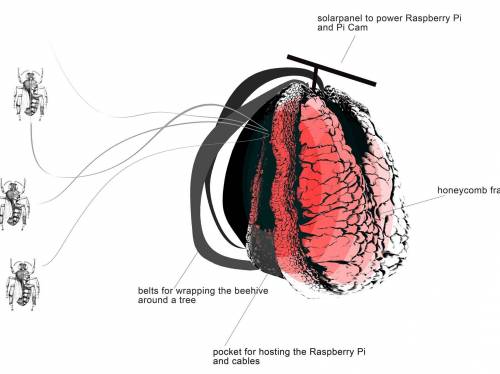 }}}}
}}}}
digital fabrication at Fab Lab Barcelona
https://es.pinterest.com/annemarie_maes/
video on the development of the Guerilla Beehive project: https://vimeo.com/171341466
pre-modeling in Blender
Guerilla Beehive backpack model
Blender modeling, inspired on a pollen grain of a Fragaria vesca (strawberry).
realtime scanning
We make the scan of the model with a Kinnect. This device is not at all precise, so the result is rather disappointing. Anastasia decides to start the design from scratch in Rhinoceros. We also will have to integrate at once the wooden (leaf-like) frames in which the bees will build their comb. It is not the purpose to open the hive once it is inhabited by a bee colony.
analogue modelling in high density foam
The inspiration for the form of the Guerilla Beehive is a SEM picture of a pollen grain of the Fragraria (Strawberry). This shape is transferred to a first design attempt in Blender. The voronoi-like texture is rather complex. I decide to make a scale model first, in high density foam. This is a traditional sculpture, the analogue way. The HD foam is a great material to work in, can make a lot of detail (but the dust gives some allergic reaction to my skin).
I finalize the skin's texture as analogue parametric design. The result looks like the structure of a nut, or a brain. The purpose is to 3D scan this model and than lasercut it in additive cork layers.
laminating in the vacuum machine
In the meantime I do tests on laminating the HD foam-model with a bioplastic skin in the vacuum machine.
The first attempt to laminate the HD foam model, is with several layers of bioplastic material that I've prepared a day before. The material is still very wet and flexible, and there are as well translucent layers as samples with coffeemix. I think we've put these samples too soon on the HD foam model. Some of them were splitting open (due to the still very jelly-like state of the substance). The importance is to find the right moment to process these casted plastics - the status between solidifying and still flexible enough to be handled and changed.
After a few hours in the vacuum machine, I took the object out and left it overnight to dry. The next morning I took off the bioplastic layers and started anew with other material. This other material is the sheet grown out of Psyllium ovata. The substance is more compact, without water but still flexible. The sample is also bigger in size, which makes it easier to cover the object in the vacuum machine.
A few questions come up during this working process. Wouldn't it be better to first seal or fill the very porous surface of the HD foam object? What material can we use for it?
Filler or sealer to flatten and seal the high density foam:
Shellac, Gesso (artist primer sealer undercoat), water based latex, water based polyurethane, PVA (wood) glue.
I did a quick test with PVA glue, and this gave an immediate result. The bio-skin was sticking better to the foam surface with glue than without. More tests should be done with Gesso or other primers.
Using a liquid mix of PVA glue and water helps to keep the lamination with bioplastics in place.
3D printing
test, model printing
http://www.thingiverse.com/thing:1309867 - solarpanel holder
The plan is to envelop the Guerilla Beehive with a kind of net in the shape of a 'grocery bag' and hang it in a tree or attach it to the wall of a building. The net-like vector-design will be cut in a sheet of bioplastic or 3D printed.
modelling in 3D Rhinoceros
Anastasia is finetuning for 2 weeks the model in Rhinoceros. We will cut a first 1:1 model in layers of cork.
The real thing will be milled in 10cm cork, a job done in 5 parts - so highly difficult and secure.
casting the model
I was also thinking to make a new and smaller model of the Guerilla Beehive in HD foam, and make a mold of it in silicone, for castings with bioplastic. I made some drawings on how to construct the mold, and my final outcome was that it has to be a silicone one - if I stay with the same design, namely 'the brain' design. I made yet some silicone molds, and those have the advantage that you can have irregular forms that can be casted - and can be taken out of the mold later.
If I want to keep the model with the voronoi-brain design, as well as the side-flaps sticking out, I will have to work with a 2-part flexible silicon model.
This model will be really small (I think 1/2 of the other model I made) and so it will be usefull only for casting and experimenting with biopolymers and document this study.
2 part plaster/silicon mold
But I hope we can still work on the 1/1 Rhinoceros 3D-file. It would be so great to work on the final design in cork.
From the point of view of a beekeeper, cork is such a nice natural product. Biopolymers cannot be used for housing a real bee colony, as this material will be eaten by the bees, as well as it will delude in water (if it rains).
Casting immediately on the object:
inserting technology
We discuss or a mesh network of thermistors inside of the double wall of the hive, or the integration of an infrared camera to check what happens inside the hive.
Integrating a camera is a lot of work and (seen the experience I've build up on this technological bee observation-matter) in my eyes rather useless. For observing the wellbeing of a colony, a network of temperature/humidity sensors is much more usefull.
Concerning the cameras:
A camera installed in the middle of the beehive will not at all work. The middle of the beehive, this is the core of the bee-nest. This is the preferred place of the queen, where she lays her eggs, where the most of the new bees are born. There is not the place for a camera, and if you would put one, it would be covered by the bees with wax immediately.
The same thing for other places in the beehive: for a camera, you need distance. Putting a camera in the beehive and realizing good results with it for monitoring, is very very very difficult.
Unless you just want to put a camera for the exhibition (proof of concept), to see inside of the hive-design: how does the hive look inside? What is new about it? How is it made? In that case, whatever setup is possible.
But if you want to do this for monitoring bees, than it asks for a long research to see what is possible with this kind of beehive - but once more: cameras are very difficult, just simply because the choice of ultra small, wide angle, short focus and infrared cameras is extremely limited. A nice project would be to design a new lens, custommade for this kind of beehive.
But as I said: this is a very long-term project, not something you develop and realize in 2 weeks.
The last years I realised 2 different setups with cameras. They were running over a whole bee-season, but we worked the whole winter fefore the start of the season on these customised setups.
Results can be followed here: http://urbanbeelab.okno.be/doku.php?id=sound_beehive#video_toolbox
and here: http://urbanbeelab.okno.be/doku.php?id=beehive_iteration_2015
This was a setup in regular beehives (which is much easier than in a Guerilla Beehive), and it was already very difficult.
Here are some photos from the setup we introduced last year in one of our beehives (the sound beehive). It is a rather complex setup. We were working with a Raspberry Pi + a hacked PiNoir camera of Raspberry.
As the image result with the PiNoir was rather blurry, we worked afterwards with a 6mm lens (still connected to Raspberry) and 2 infrared Leds. Here are some pictures of the setup - but this setup asks for a lot of space (to host the Raspberry Pi + all cables) and also we need enough distance from the object (the bee nest).
Pi Cam
extension cable for PiCam on Raspberry Pi
powering-a-raspberry-pi-from-solar-power
solar-arduino-guide
I think we will have to go for an image-stopmotion setup (instead of video). The processing of video will not be possible in a stand alone version with solarpanel. Maybe we will have to work with a combination of Arduino and Raspberry Pi, in order to save energy consumption of the Pi and switch on the Pi only when necessary.
But everything depends on what is the goal of the project.
Is the goal bee monitoring?
Is the goal designing a Guerilla Beehive: a sustainable shelter for honeybees in context of biodiversity?
For me it is clearly the last. Therefore, an alternative is to install a mesh network of thermistors.
I think it is much more interesting and helpfull for the disappearing bees (and as well for the wellbeing of our ecosystem) to support the bees with shelters that are adapted to their needs (read: hives build out of natural materials with bee-supporting properties) than to design a bee shelter enhanced with (intrusive) technology.
Later, if we have more time and money, we can try to enhance the same model with technology that is custom developed for this model beehive: camera with custom adapted lens.
If we want to add technology right away, and one that is usefull in terms of monitoring, than we should go for the mesh network of thermistors. They measure what is most important in context of bee monitoring: the temperature and the humidity in the nest, compared to the temperature and humidity of the surrounding outside - and how they relate to each other.
2016 research stops here
Documentation phase#01: membranes, scoby skins
see also:
http://annemariemaes.net/presentations/bee-laboratory-presentations-2/sensorial-skin-exhibition/
https://www.facebook.com/pageannemariemaes/
Inspirational Projects
3D printed Human Skin

